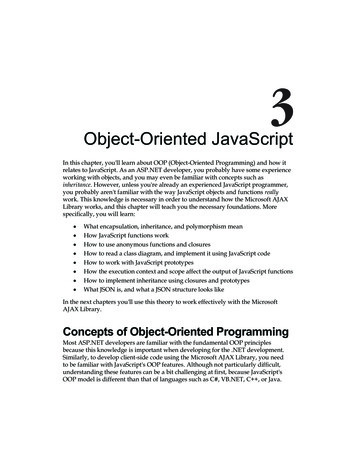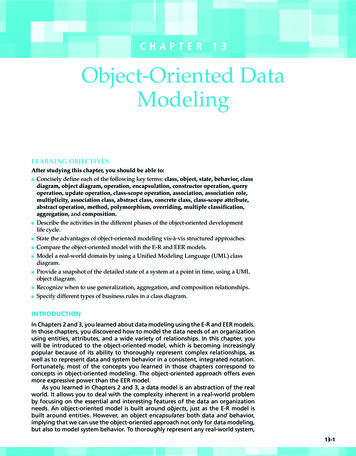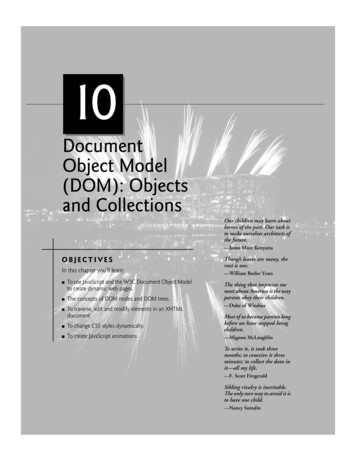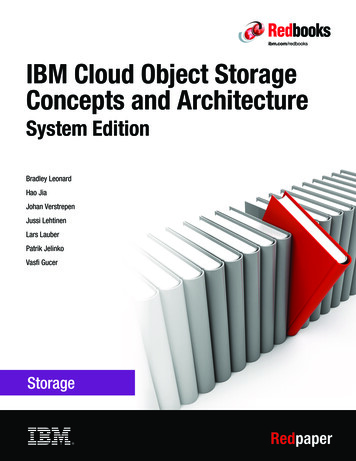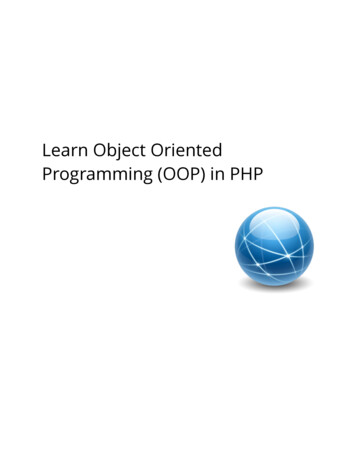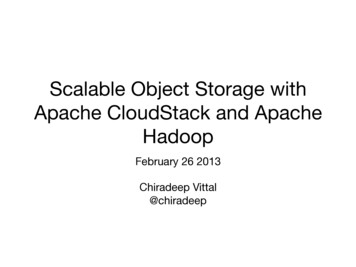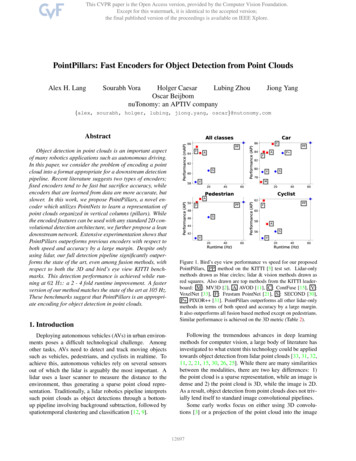
Transcription
PointPillars: Fast Encoders for Object Detection from Point CloudsAlex H. LangSourabh VoraHolger CaesarLubing ZhouOscar BeijbomnuTonomy: an APTIV companyJiong Yang{alex, sourabh, holger, lubing, jiong.yang, oscar}@nutonomy.comAll classes1. IntroductionDeploying autonomous vehicles (AVs) in urban environments poses a difficult technological challenge. Amongother tasks, AVs need to detect and track moving objectssuch as vehicles, pedestrians, and cyclists in realtime. Toachieve this, autonomous vehicles rely on several sensorsout of which the lidar is arguably the most important. Alidar uses a laser scanner to measure the distance to theenvironment, thus generating a sparse point cloud representation. Traditionally, a lidar robotics pipeline interpretssuch point clouds as object detections through a bottomup pipeline involving background subtraction, followed byspatiotemporal clustering and classification [12, 9].64F86PPA848262V2040PedestrianA50 F4862PP60S4642V562040Runtime (Hz)60SM204060CyclistPPF5844P V60PPAF78Performance (AP)58CarC80S60Performance (AP)Object detection in point clouds is an important aspectof many robotics applications such as autonomous driving.In this paper, we consider the problem of encoding a pointcloud into a format appropriate for a downstream detectionpipeline. Recent literature suggests two types of encoders;fixed encoders tend to be fast but sacrifice accuracy, whileencoders that are learned from data are more accurate, butslower. In this work, we propose PointPillars, a novel encoder which utilizes PointNets to learn a representation ofpoint clouds organized in vertical columns (pillars). Whilethe encoded features can be used with any standard 2D convolutional detection architecture, we further propose a leandownstream network. Extensive experimentation shows thatPointPillars outperforms previous encoders with respect toboth speed and accuracy by a large margin. Despite onlyusing lidar, our full detection pipeline significantly outperforms the state of the art, even among fusion methods, withrespect to both the 3D and bird’s eye view KITTI benchmarks. This detection performance is achieved while running at 62 Hz: a 2 - 4 fold runtime improvement. A fasterversion of our method matches the state of the art at 105 Hz.These benchmarks suggest that PointPillars is an appropriate encoding for object detection in point clouds.Performance (mAP)66Performance (AP)AbstractASV2040Runtime (Hz)60Figure 1. Bird’s eye view performance vs speed for our proposedPointPillars, PP method on the KITTI [5] test set. Lidar-onlymethods drawn as blue circles; lidar & vision methods drawn asred squares. Also drawn are top methods from the KITTI leaderboard: M : MV3D [2], A AVOD [11], C : ContFuse [15], V :VoxelNet [33], F : Frustum PointNet [21], S : SECOND [30],P PIXOR [31]. PointPillars outperforms all other lidar-onlymethods in terms of both speed and accuracy by a large margin.It also outperforms all fusion based method except on pedestrians.Similar performance is achieved on the 3D metric (Table 2).Following the tremendous advances in deep learningmethods for computer vision, a large body of literature hasinvestigated to what extent this technology could be appliedtowards object detection from lidar point clouds [33, 31, 32,11, 2, 21, 15, 30, 26, 25]. While there are many similaritiesbetween the modalities, there are two key differences: 1)the point cloud is a sparse representation, while an image isdense and 2) the point cloud is 3D, while the image is 2D.As a result, object detection from point clouds does not trivially lend itself to standard image convolutional pipelines.Some early works focus on either using 3D convolutions [3] or a projection of the point cloud into the image12697
[14]. Recent methods tend to view the lidar point cloudfrom a bird’s eye view (BEV) [2, 11, 33, 32]. This overhead perspective offers several advantages. First, the BEVpreserves the object scales. Second, convolutions in BEVpreserve the local range information. If one instead performs convolutions in the image view, one is blurring thedepth information (Fig. 3 in [28]).However, the bird’s eye view tends to be extremelysparse which makes direct application of convolutionalneural networks impractical and inefficient. A commonworkaround to this problem is to partition the ground planeinto a regular grid, for example 10 x 10 cm, and then perform a hand-crafted feature encoding method on the pointsin each grid cell [2, 11, 26, 32]. However, such methodsmay be sub-optimal since the hard-coded feature extractionmethod may not generalize to new configurations withoutsignificant engineering efforts. To address these issues, andbuilding on the PointNet design developed by Qi et al. [22],VoxelNet [33] was one of the first methods to truly do endto-end learning in this domain. VoxelNet divides the spaceinto voxels, applies a PointNet to each voxel, followed bya 3D convolutional middle layer to consolidate the verticalaxis, after which a 2D convolutional detection architectureis applied. While the VoxelNet performance is strong, theinference time, at 4.4 Hz, is too slow to deploy in real time.Recently SECOND [30] improved the inference speed ofVoxelNet but the 3D convolutions remain a bottleneck.In this work, we propose PointPillars: a method for object detection in 3D that enables end-to-end learning withonly 2D convolutional layers. PointPillars uses a novel encoder that learns features on pillars (vertical columns) of thepoint cloud to predict 3D oriented boxes for objects. Thereare several advantages of this approach. First, by learningfeatures instead of relying on fixed encoders, PointPillarscan leverage the full information represented by the pointcloud. Further, by operating on pillars instead of voxelsthere is no need to tune the binning of the vertical directionby hand. Finally, pillars are fast because all key operationscan be formulated as 2D convolutions which are extremelyefficient to compute on a GPU. An additional benefit oflearning features is that PointPillars requires no hand-tuningto use different point cloud configurations such as multiplelidar scans or even radar point clouds.We evaluated our PointPillars network on the publicKITTI detection challenges which require detection of cars,pedestrians, and cyclists in either BEV or 3D [5]. Whileour PointPillars network is trained using only lidar pointclouds, it dominates the current state of the art includingmethods that use lidar and images, thus establishing newstandards for performance on both BEV and 3D detection(Table 1 and Table 2). At the same time, PointPillars runsat 62 Hz, which is 2-4 times faster than previous state ofthe art (Figure 1). PointPillars further enables a trade offbetween speed and accuracy; in one setting we match stateof the art performance at over 100 Hz (Figure 5). We havealso released code1 to reproduce our results.1.1. Related Work1.1.1Object detection using CNNsStarting with the seminal work of Girshick et al. [6], it wasestablished that convolutional neural network (CNN) architectures are state of the art for detection in images. Theseries of papers that followed [24, 7] advocate a two-stageapproach to this problem. In the first stage, a region proposal network (RPN) suggests candidate proposals, whichare cropped and resized before being classified by a secondstage network. Two-stage methods dominated the importantvision benchmark datasets such as COCO [17] over singlestage architectures originally proposed by Liu et al. [18]. Ina single-stage architecture, a dense set of anchor boxes isregressed and classified in one step into a set of predictionsproviding a fast and simple architecture. Recently, Lin etal. [16] convincingly argued that with their proposed focalloss function a single stage method is superior to two-stagemethods, both in terms of accuracy and runtime. In thiswork, we use a single stage method.1.1.2Object detection in lidar point cloudsObject detection in point clouds is an intrinsically three dimensional problem. As such, it is natural to deploy a 3Dconvolutional network for detection, which is the paradigmof several early works [3, 13]. While providing a straightforward architecture, these methods are slow; e.g. Engelckeet al. [3] require 0.5s for inference on a single point cloud.Most recent methods improve the runtime by projecting the3D point cloud either onto the ground plane [11, 2] or theimage plane [14]. In the most common paradigm the pointcloud is organized in voxels and the set of voxels in eachvertical column is encoded into a fixed-length, hand-crafted,feature encoding to form a pseudo-image which can be processed by a standard image detection architecture. Somenotable works include MV3D [2], AVOD [11], PIXOR [32]and Complex YOLO [26] which all use variations on thesame fixed encoding paradigm as the first step of their architectures. The first two methods additionally fuse the lidar features with image features to create a multi-modal detector. The fusion step used in MV3D and AVOD forcesthem to use two-stage detection pipelines, while PIXORand Complex YOLO use single stage pipelines.In their seminal work Qi et al. [22, 23] proposed a simplearchitecture, PointNet, for learning from unordered pointsets, which offered a path to full end-to-end learning. VoxelNet [33] is one of the first methods to deploy PointNetsfor object detection in lidar point clouds. In their method,1 https://github.com/nutonomy/second.pytorch12698
Point cloudPredictionsPillarFeature NetPointcloudStackedPillarsDetectionHead (SSD)Backbone(2D ar IndexCPCW/4HWH/2H/2W/22C W/2ConvDeconvH/4H/84C W/8ConcatH/22C W/2ConvDeconvH/26C W/2H/22C W/2Figure 2. Network overview. The main components of the network are a Pillar Feature Network, Backbone, and SSD Detection Head (seeSection 2 for details). The raw point cloud is converted to a stacked pillar tensor and pillar index tensor. The encoder uses the stackedpillars to learn a set of features that can be scattered back to a 2D pseudo-image for a convolutional neural network. The features from thebackbone are used by the detection head to predict 3D bounding boxes for objects. Note: we show the car network’s backbone dimensions.PointNets are applied to voxels which are then processed bya set of 3D convolutional layers followed by a 2D backboneand a detection head. This enables end-to-end learning, butlike the earlier work that relied on 3D convolutions, VoxelNet is slow, requiring 225ms inference time (4.4 Hz) for asingle point cloud. Another recent method, Frustum PointNet [21], uses PointNets to segment and classify the pointcloud in a frustum generated from projecting a detection onan image into 3D. Frustum PointNet achieved high benchmark performance compared to other fusion methods, butits multi-stage design makes end-to-end learning impractical. Very recently SECOND [30] offered a series of improvements to VoxelNet resulting in stronger performanceand a much improved speed of 20 Hz. However, they wereunable to remove the expensive 3D convolutional layers.1.2. Contributions We propose a novel point cloud encoder and network,PointPillars, that operates on the point cloud to enableend-to-end training of a 3D object detection network. We show how all computations on pillars can be posedas dense 2D convolutions which enables inference at62 Hz; a factor of 2-4 times faster than other methods. We conduct experiments on the KITTI dataset anddemonstrate state of the art results on cars, pedestrians, and cyclists on both BEV and 3D benchmarks. We conduct several ablation studies to examine the keyfactors that enable a strong detection performance.2. PointPillars NetworkPointPillars accepts point clouds as input and estimatesoriented 3D boxes for cars, pedestrians and cyclists. It consists of three main stages (Figure 2): (1) A feature encodernetwork that converts a point cloud to a sparse pseudoimage; (2) a 2D convolutional backbone to process thepseudo-image into high-level representation; and (3) a detection head that detects and regresses 3D boxes.2.1. Pointcloud to Pseudo-ImageTo apply a 2D convolutional architecture, we first convert the point cloud to a pseudo-image.We denote by l a point in a point cloud with coordinatesx, y, and z. As a first step, the point cloud is discretizedinto an evenly spaced grid in the x-y plane, creating a setof pillars P with P B. Note that a pillar is a voxelwith unlimited spatial extent in the z direction and hencethere is no need for a hyper parameter to control the binning in the z dimension. The points in each pillar are thendecorated (augmented) with r, xc , yc , zc , xp , yp where ris reflectance, the c subscript denotes distance to the arithmetic mean of all points in the pillar, and the p subscriptdenotes the offset from the pillar x, y center (see Sec 7.3 fordesign details). The decorated lidar point ˆl is now D 9dimensional. While we focus on lidar point clouds, otherpoint clouds such as radar or RGB-D[27] could be used withPointPillars by changing the decorations for each point.The set of pillars will be mostly empty due to sparsityof the point cloud, and the non-empty pillars will in generalhave few points in them. For example, at 0.162 m2 binsthe point cloud from an HDL-64E Velodyne lidar has 6k-9knon-empty pillars in the range typically used in KITTI for 97% sparsity. This sparsity is exploited by imposing alimit both on the number of non-empty pillars per sample(P ) and on the number of points per pillar (N ) to create adense tensor of size (D, P, N ). If a sample or pillar holdstoo much data to fit in this tensor, the data is randomly sampled. Conversely, if a sample or pillar has too little data topopulate the tensor, zero padding is applied.Next, we use a simplified version of PointNet where,for each point, a linear layer is applied followed by BatchNorm [10] and ReLU [19] to generate a (C, P, N
Point cloud N P D C P H W C Deconv Deconv Deconv Concat Conv Conv Conv H/2 W/2 C H/4 W/4 2C H/8 4C W/8 H/2 W/2 2C H/2 2CW/2 H/2 2C W/2 H/2 W/2 6C Pillar Index Figure 2. Network overview. The main components of the network are a Pillar Feature Network, Backbone, and SSD Detection Head (see Section 2 for details). The raw point cloud is converted to a stacked pillar tensor and pillar index .
